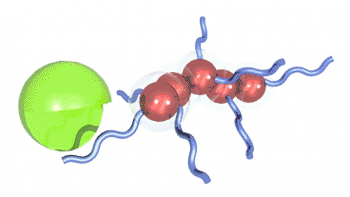Nanoparticles Designed for Earlier Cancer Diagnosis
By LabMedica International staff writers
Posted on 16 Jan 2013
Detecting cancer earlier could greatly improve the chances of survival for many patients. One way to achieve this is to search for specific proteins secreted by cancer cells, which circulate in the bloodstream. However, the quantity of these biomarkers is so low that detecting them has been difficult. A newly developed technology has the potential to make biomarker detection much simpler. Posted on 16 Jan 2013
The Massachusetts Institute of Technology (MIT; Cambridge, MA, USA) researchers, led by Dr. Sangeeta Bhatia, have developed nanoparticles that can zoom to a tumor and interact with cancer proteins to generate thousands of biomarkers, which can then be simply detected in the patient’s urine.

Image: These nanoparticles created by MIT engineers can act as synthetic biomarkers for disease. The particles (brown) are coated with peptides (blue) that are cleaved by enzymes (green) found at the disease site. The peptides then accumulate in the urine, where they can be detected using mass spectrometry (Photo courtesy of Justin H. Lo).
This biomarker amplification system could also be used to monitor disease progression and monitor how tumors respond to treatment, according to Dr. Bhatia, a professor of health sciences and technology and electrical engineering and computer science at MIT. “There’s a desperate search for biomarkers, for early detection or disease prognosis, or looking at how the body responds to therapy,” stated Dr. Bhatia, who is also a member of MIT’s David H. Koch Institute for Integrative Cancer Research. She added that the search has been difficult because genomic research have revealed that many cancers, such as breast cancer, are actually groups of several diseases with different genetic signatures.
The MIT team, working with researchers from Beth Israel Deaconess Medical Center (Boston, MA, USA), described the new technology in a paper appearing in the journal Nature Biotechnology on December 16, 2012. Lead author of the article is Gabriel Kwong, a postdoctoral candiate in MIT’s Institute for Medical Engineering and Science and the Koch Institute.
Cancer cells generate many proteins not found in healthy cells. However, these proteins are frequently so diluted in the bloodstream that they are nearly impossible to detect. A recent study from Stanford University (Stanford, CA, USA) researchers found that even using the best existing biomarkers for ovarian cancer, and the best technology to detect them, an ovarian tumor would not be found until eight to 10 years after it formed. “The cell is making biomarkers, but it has limited production capacity,” Dr. Bhatia remarked. “That’s when we had this ‘aha’ moment: What if you could deliver something that could amplify that signal?”
Coincidently, Dr. Bhatia’s lab was already working on nanoparticles that could be utilized to detect cancer biomarkers. Originally intended as imaging agents for tumors, the particles interact with enzymes called proteases, which cleave proteins into smaller fragments.
Cancer cells often produce large quantities of proteases called matrix metalloproteinases (MMPs). These proteases help cancer cells escape their original locations and spread uncontrollably by cutting through proteins of the extracellular matrix, which normally holds cells in place. The researchers glazed their nanoparticles with peptides (short protein fragments) targeted by several of the MMP proteases. The treated nanoparticles gather at tumor sites, making their way through the leaky blood vessels that typically surround tumors. There, the proteases cleave hundreds of peptides from the nanoparticles, releasing them into the bloodstream. The peptides rapidly accumulate in the kidneys and are expelled in the urine, where they can be detected using mass spectrometry.
This new system is an exciting way of resolving the problem of the lack of biomarkers in the body, noted Dr. Sanjiv Gambhir, chairman of the department of radiology at Stanford University School of Medicine. “Instead of being dependent on the body to naturally shed biomarkers, you’re sampling the site of interest and causing biomarkers that you engineered to be released,” said Dr. Gambhir, who was not part of the research team.
To make the biomarker readings as exact as possible, the researchers designed their particles to express 10 different peptides, each of which is cleaved by a different one of the dozens of MMP proteases. Each of these peptides is a different size, making it possible to differentiate them with mass spectrometry. This should allow researchers to identify distinctive signatures associated with different types of tumors.
In this study, the researchers assessed their nanoparticles’ ability to identify the early stages of colorectal cancer in mice, and to monitor the progression of liver fibrosis, which is an accumulation of scarring in response to liver injury or chronic liver disease. Patients with this disorder have to be routinely monitored by biopsy, which is expensive and invasive, to make sure they are getting the appropriate treatment. In lab mice, the researchers discovered that the nanoparticles could offer much more rapid feedback than biopsies.
The scientists also found that the nanoparticles could accurately reveal the early formation of colorectal tumors. In ongoing studies, the team is evaluating the particles’ ability to measure tumor response to chemotherapy and to detect metastasis.
Related Links:
Massachusetts Institute of Technology
Beth Israel Deaconess Medical Center














